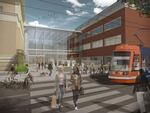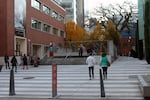
Early renderings of the Rothko entrance from 10th Street and the streetcar stop.
Courtesy of the Portland Art Museum
On Wednesday, Portland City Council voted 3-1 to allow the Portland Art Museum to move forward with the controversial new Rothko Pavilion.
The museum announced plans for the pavilion a year ago. It would serve as a new entrance that would connect the museum's two existing buildings and fix its notoriously inaccessible and confusing layout. [Listen to our story about navigating the museum from a wheelchair.]
“The public interest in my view overwhelms the inconvenience this may cause to some people in the neighborhood,” said Commissioner Nick Fish. “And that’s because we have a chance to have an art museum that sets a standard for accessibility on the West Coast and beyond.”
Invoking the vision of Vera Katz, whose passing the council had honored earlier in the morning, Commissioner Fish said the Rothko Pavilion was a project that looked to the long term good of the city.
“The number one goal was connectivity and accessibility,” said Brian Ferriso, the museum’s director and chief curator.
The museum technically owns the plaza and pedestrian thoroughfare between its two buildings on Madison Street, but there is a city easement requiring an 8-foot-wide public passage way between 7 a.m. and 11 p.m. and forbids the construction of a building. So in April, the museum approached the city to amend the ordinance to allow a building and limit the passage hours to museum business hours.
At the first city council hearing in April, neighbors and disability, pedestrian and bicycle advocates turned out en masse to argue against the pavilion. They said it would create a superblock that obstructs a passage that people rely on for traveling between downtown, the Park Blocks, and the street car stop on 10th Avenue, creating a burden for individuals with mobility challenges.

An early rendering of the Rothko Pavilion, the proposed new entrance to the Portland Art Museum that would connect its two buildings. Details like the placement of doors and ramps are still to be determined.
Courtesy of the Portland Art Museum
“There’s so many reasons for that passageway to stay open,” said Wendy Rahm, who lives across the street from the museum. “Probably the most important is to accommodate those with disabilities. Other reasons to keep the passageway open 24/7 is that it’s part of the comprehensive plan that promotes walkability in neighborhoods. This certainly will not promote walkability.”
The museum pulled back its proposal over the summer to meet with neighbors and disability rights advocates and began to put together a disability advisory board. They then returned to city hall last week for a first hearing on an altered proposal: the museum would keep the building open to the public for the plaza’s current hours, from 7 a.m. to 11 p.m., and allow pets and individuals with bikes to pass through.
More than 60 citizens spoke at the council hearing on the new proposal. They were relatively evenly split between supporters of the Rothko Pavilion and detractors who argued that any building should be required to have an external passageway through it.
“This museum expansion greatly excites me because I and thousands of other people will be able to more fully enjoy and appreciate the museum and its treasures,” said Larry Cross, a self-identified person with a disability and a commissioner on the Portland Commission on Disability. “I think it should be viewed as the Rothko Connection — it’s connecting these buildings, and it will create one seamless museum campus, dramatically increasing the accessibility and visitability of the museum.”
“Our streets are not up for grabs by the nearest cultural institution,” said Laura Foster, the author of seven pedestrian guidebooks to Portland.” The Portland Art Museum’s stated intention to build walls across this common space seems unthinkable to me. The glass walls do not invite passage, they convey privilege.”

Currently, the stretch of Madison Street between the museum's two buildings serves as a plaza, passageway, and sculpture garden. The only ramp entry to the museum is hidden behind the stairs.
Aaron Scott / OPB
On Wednesday, city council voted 3-1 in favor of changing the ordinance to allow the museum to build a structure across the plaza. In response to concerns, the ordinance was also changed to expand the hours that the art museum must be open to the public to the hours of the street car, which are beyond the current requirement of 7 a.m. to 11 p.m.
“It’s very clear to me that the benefits to the art museum are obvious and plenty; the benefits to the community of closing off the right of way are undetermined at best,” said Commissioner Amanda Fritz, the dissenting vote, who expressed concern not just for the superblock it would create, but the fear many critics voiced that the museum would be back in several years to limit the public hours. “I’m disappointed that we’re not able to get to more of a win-win situation.”
Ferriso said the museum still has $20 million to raise towards the project’s $50 million price tag, and that they look forward to working with neighbors and advocates as they continue to develop the final plans for the Rothko Pavilion, which will have to go before the Historic Landmarks Commission, allowing for another round of public input.
